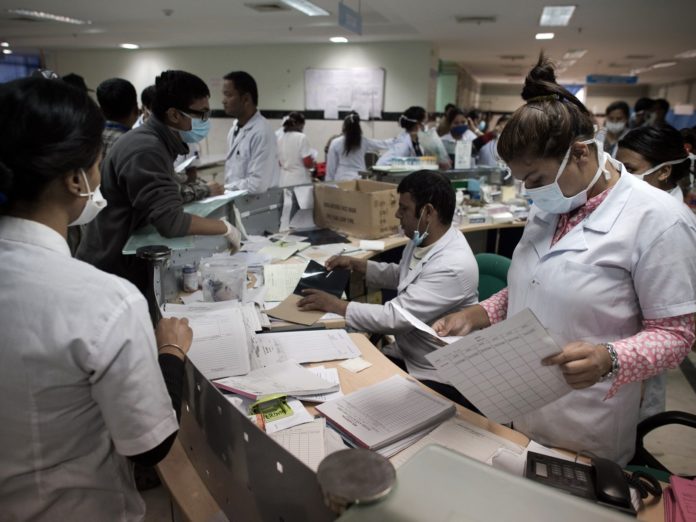Hospital staff members work at the reception area of a hospital in Kathmandu. Some 14,000 were injured in Nepal’s earthquake. Nicolas Asfouri/AFP/Getty Images hide caption
itoggle caption Nicolas Asfouri/AFP/Getty Images

Hospital staff members work at the reception area of a hospital in Kathmandu. Some 14,000 were injured in Nepal’s earthquake.
Nicolas Asfouri/AFP/Getty Images
An estimated 14,000 were injured in April’s earthquake in Nepal. The caseload is overwhelming hospitals in Kathmandu, says Dr. Bianca Grecu-Jacobs, a resident in emergency medicine from California who was working in Nepal when the quake struck.
“[In] the lobby areas, patients just are on the floor waiting,” Grecu-Jacobs says via Skype from Katmandu. “They strung up IVs for patients who need them in whatever manner they can.”
Grecu-Jacobs is now helping out in a hospital with logistics, working on sanitation and trying to prevent infections. The day of the earthquake, she says, she had been enjoying a bit of a holiday, mountain biking with colleagues. Suddenly, everything changed.
“We felt it,” she tells NPR’s Rachel Martin. “The first thing that we noticed was a house: One of the walls had just fallen down in a huge cloud of dust. It was almost like an explosion happened.”
Interview Highlights
Hospitals’ biggest problems
With those crowded conditions also come concerns with sanitation and infections. Many patients have open wounds that are now being exposed to other patients with similar conditions, dirt. People … weren’t able to be properly cared for quite some time before getting to a hospital. So cleanliness is also an issue, along with space.
Many locations have power
The infrastructure in Kathmandu prior to the quake was not wonderful, so actually many homes, hotels, hospitals actually have their own independent power supplies. There are solar powers all over the city. Many places have generators.
The challenge of homeless patients
The hospital is also struggling with where to discharge patients. Even patients who otherwise don’t need the hospital have nowhere to go. They have no home; they have no clean environment, so even if they have wounds that could be cared for at home, the concern is that if there’s no home, how will they care for those wounds? Will they just come back again with another infection?

